 Before we go further south, we drive to the north of Ethiopia for a tour around the beautiful Ethiopian Highlands. First to Gonder, a medium-sized provincial town north of Gorgora. There we can withdraw money, buy motor insurance and hopefully get internet access. At Tim and Kim we could not access to the Internet, but the blog could use an update and we would like to read some emails. After Gonder we drive on towards the Siemien Mountains and the rock churches in the Tigray province.
Before we go further south, we drive to the north of Ethiopia for a tour around the beautiful Ethiopian Highlands. First to Gonder, a medium-sized provincial town north of Gorgora. There we can withdraw money, buy motor insurance and hopefully get internet access. At Tim and Kim we could not access to the Internet, but the blog could use an update and we would like to read some emails. After Gonder we drive on towards the Siemien Mountains and the rock churches in the Tigray province.
It is not as busy as during “market day”, but there are still plenty of people and animals on the road. We are now better prepared and drive at an appropriate speed on the gravel road back to the main road. We arrive in Gonder in the beginning of the afternoon. We need to refuel. Like in Sudan and Egypt, gasoline is hardly available in Ethiopia. At the first station, the attendant comes to meet us while shaking his head, he has no ‘regular’. He refers us to a gas station a few miles away. But even at that gas station and the next six(!) stations then they cannot help us. Let’s first find a place to sleep before we continue the search for gasoline.
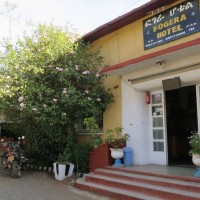 At the Fogera hotel we find a simple room. In the reception there is a large sign that says “Free WiFi”. Great, because that was one of the things we wanted to settle in Gonder. But unfortunately, we cheered too soon. While we get plenty of connection to the Wi-Fi network, we have no access to the Internet. We still need to go to the city centre to get on the Internet in another way. Once in the centre we pass ETC Telecom. ETC provides postal services and owns all Ethiopian telecommunications. Maybe they can activate our simcard.
At the Fogera hotel we find a simple room. In the reception there is a large sign that says “Free WiFi”. Great, because that was one of the things we wanted to settle in Gonder. But unfortunately, we cheered too soon. While we get plenty of connection to the Wi-Fi network, we have no access to the Internet. We still need to go to the city centre to get on the Internet in another way. Once in the centre we pass ETC Telecom. ETC provides postal services and owns all Ethiopian telecommunications. Maybe they can activate our simcard.
In Africa, they more or less skipped the communication via land lines and immediately went mobile. It is not expensive. A prepaid ticket only costs 30 Ethiopian Birr (€1.12) and phones, especially the older models, are less than 270 Birr (€10). The number of mobile connections in Ethiopia has risen so quickly that the network cannot handle it. Especially for mobile Internet the network does not have enough capacity. A problem that will not simply be solved, because the number of mobile connections increases everyday. While I am waiting my turn at ETC, one mobile phone after another is sold. Some customers do not even have decent shoes, but they do have the required amount to buy a phone. Very remarkable.
Once it is my turn, a friendly lady informs me that I will not be able to access the Internet with our simcard. For Internet we need a different simcard or a dongle. For a dongle she refers us to a shop in the centre. In the shop we are served by Sammy, a young whiz-kid who speaks little English. After we have paid for one of his dongles, he ask for my phone. Before I know he has changed some settings and gives me back my phone grinning: “You have internet in half an hour. No problem“. Great, at least that is something.
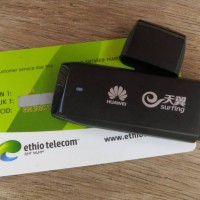 Back at the friendly lady at ETC I give her the dongle, a passport photo and a copy of my passport. It may not cost much, it does require a comprehensive registration. Once she tries to register the dongle it appears the device does not work. We go back to Sammy. From his warehouse he grabs all dongles that he has to join us to the ETC building. Together with the ETC lady he tries to register one of the dongles for us. It is now well past 17:00 and colleagues of the kind lady leave their workplace one by one. Several times we propose to come back the next day, but she says that wont be necessary, she will finish it tonight. What a service! Ultimately, it is almost 19:00 when one of the dongles is successful registered. We still did not manage to get on the internet, but was due to the crowded ETC network.
Back at the friendly lady at ETC I give her the dongle, a passport photo and a copy of my passport. It may not cost much, it does require a comprehensive registration. Once she tries to register the dongle it appears the device does not work. We go back to Sammy. From his warehouse he grabs all dongles that he has to join us to the ETC building. Together with the ETC lady he tries to register one of the dongles for us. It is now well past 17:00 and colleagues of the kind lady leave their workplace one by one. Several times we propose to come back the next day, but she says that wont be necessary, she will finish it tonight. What a service! Ultimately, it is almost 19:00 when one of the dongles is successful registered. We still did not manage to get on the internet, but was due to the crowded ETC network.
That evening we try to get on the Internet with the dongle several times. Unfortunately without any luck. The internet on my phone does work! We can already read some of our emails. The next morning we go back to ETC with Sammy. The conclusion remains unchanged; the dongle works, the faulty network is the real problem. We will see about that later.
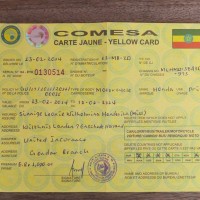 Now we can start the next administrative task: motorcycle insurance. In Sudan we had tried to get a ‘yellow card’ for Africa in Khartoum, but we did not succeed (see “Chat in Khartoum”). We should be able to buy COMESA insurance in Ethiopia. At the first insurance office they luckily know what Comesa is and they can also sell it to us. Peter goes with the manager while I stay outside with our bikes. Like all administrative matters in Africa this also takes very long, but the long wait is rewarded. Three hours later Peter comes out with a yellow card for Africa for both of us. Great, that’s settled. Now we can look for gasoline again.
Now we can start the next administrative task: motorcycle insurance. In Sudan we had tried to get a ‘yellow card’ for Africa in Khartoum, but we did not succeed (see “Chat in Khartoum”). We should be able to buy COMESA insurance in Ethiopia. At the first insurance office they luckily know what Comesa is and they can also sell it to us. Peter goes with the manager while I stay outside with our bikes. Like all administrative matters in Africa this also takes very long, but the long wait is rewarded. Three hours later Peter comes out with a yellow card for Africa for both of us. Great, that’s settled. Now we can look for gasoline again.
In the centre of town is a gas station that we had not tried before. There is a long line of cars and -more importantly- a long line of tuk-tuks and motorbikes. Cars and trucks mostly take diesel, but tuk-tuks and motorbikes use gasoline like us. We join the queue and drive little by little to the pump. Once there, it appears that there are two lines; one with vehicles and one with people with jerrycans. A spirited lady at the pump keeps a close eye on everybody and gives everyone the required gasoline in turn. Full tanks means that we now only have to find a bank to withdraw some money.
In the centre we find a bank where the Visa card of Peter is accepted. We withdraw enough money for the next few days and then can finally  go! We turn on the road and open the gas to drive out of town. Then I hear Peter grumbling. The GPS is still at the insurance office, we have to turn around. Unfortunately, it is now lunch time and the office is closed for the next two hours. We also have an extensive lunch and park our bikes in front of the insurance office 1.5 hours later. One of the ladies already comes out out of the building with the GPS high in the air. Relieved that the GPS is not gone, we drive out of town. Without a working dongle, but with mobile internet, insurance, a full wallet, a full tank and good spirits to finally head north.
go! We turn on the road and open the gas to drive out of town. Then I hear Peter grumbling. The GPS is still at the insurance office, we have to turn around. Unfortunately, it is now lunch time and the office is closed for the next two hours. We also have an extensive lunch and park our bikes in front of the insurance office 1.5 hours later. One of the ladies already comes out out of the building with the GPS high in the air. Relieved that the GPS is not gone, we drive out of town. Without a working dongle, but with mobile internet, insurance, a full wallet, a full tank and good spirits to finally head north.
Once we are out of town we immediately drive on a beautiful road into the hills. What is striking is that virtually every piece of land is cultivated. On steep slopes terraces are made to grow different crops. There was not much rain lately, so the fields are dry and yellow. From the high road, we look down on a yellow patchwork blanket. It is really beautiful. Behind every corner lurks another view. We stop very often to take some pictures and look at the views. And while we often think we are alone, this never turns out to be the case. Once we kill 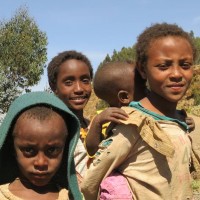 http://amsterdamtoanywhere.nl/wp-admin/post.php?post=1977&action=edit&message=1our engines we hear someone shouting in the distance: “You, you, you, Faranji“. Before we know it there are a number of spectators around us who watch us take pictures, drink or try to eat a banana. The latter is still a bit tricky if you have a group of children with hungry eyes around you that have one hand to their mouth to indicate they would like something to eat or drink.
http://amsterdamtoanywhere.nl/wp-admin/post.php?post=1977&action=edit&message=1our engines we hear someone shouting in the distance: “You, you, you, Faranji“. Before we know it there are a number of spectators around us who watch us take pictures, drink or try to eat a banana. The latter is still a bit tricky if you have a group of children with hungry eyes around you that have one hand to their mouth to indicate they would like something to eat or drink.
At dusk we arrive in Debark. The town is situated at 2800 meters altitude and is the starting point for hikes in Simien Mountains National Park. For the first time since a long time we see a lot of tourists and tour groups. It is so busy that the first three hotel where go are full, even camping is not possible. We eventually find a single room with a cozy bed. There is no running water. In the corner of the tiny little bathroom is a big bucket of water to wash and to flush the toilet. Despite the fact that we sleep in one of the better hotels in the town it still feels a bit like bush camping.
We decide not to go hiking in the Simien Mountains. We are both not really in shape so we decide to drive to Axum the next day. We attempt to fill our tanks again, but soon get told that we can only get gasoline in Axum. Even on the black market in Debark there is no petrol. With our extra jerrycan of gasoline we should be able to make it to the next pump.
 Once we leave the village, we also leave the asphalt road and ride on a nice gravel road. Here and there are deep patches of gravel which make the bike ’dance’, but overall it is good to drive. Though we are standing still more than we are riding, because it is so beautiful we frequently stop to take pictures. The views, steep cliffs and the shapes of the hills are very impressive. The only traffic that we encounter are coaches that chug slowly up to the mountain and then roll down the hills at high speed. Behind the coach there is a huge cloud of dust. So much dust that we often have to stop to avoid that we would drive off the road.
Once we leave the village, we also leave the asphalt road and ride on a nice gravel road. Here and there are deep patches of gravel which make the bike ’dance’, but overall it is good to drive. Though we are standing still more than we are riding, because it is so beautiful we frequently stop to take pictures. The views, steep cliffs and the shapes of the hills are very impressive. The only traffic that we encounter are coaches that chug slowly up to the mountain and then roll down the hills at high speed. Behind the coach there is a huge cloud of dust. So much dust that we often have to stop to avoid that we would drive off the road.
Halfway through the day we run into a traffic jam. Along the entire route there are road works. As in Sudan, the Chinese also build new roads in Ethiopia. With local workers, they cut out the mountains and smooth the gravel to pour a layer of asphalt on it. The traffic jam is caused by two large machines that are cutting out the mountain to make the road slightly wider. No luxury, because it was not wide enough for two buses to pass. We ride our bikes along the long line of waiting cars until we cannot go any further and join the other spectators. Between all Ethiopians is one  “Faranji”, Brian from the U.S. He is on the bus to Axum and has been waiting there for several hours to wait until the road reopens. While we are talking to him, one of the machines moves and we can ride bikes along the road works. We say goodbye to Brian, manoeuvring past the machines and continue our way up. For now without any coaches in front of us.
“Faranji”, Brian from the U.S. He is on the bus to Axum and has been waiting there for several hours to wait until the road reopens. While we are talking to him, one of the machines moves and we can ride bikes along the road works. We say goodbye to Brian, manoeuvring past the machines and continue our way up. For now without any coaches in front of us.
If after a few kilometres we look back, we see that the road is open again and the coaches are in hot pursuit. While we stop for a sandwich the first buses and their dust overtake us. After lunch we take over the coaches again, but each time we stop to take a picture, we are caught up and have to overtake them again afterwards to avoid the dust. This ritual is repeated several times, until we arrive at the tarmac in Shire. In the last sunlight we drive from Shire to Axum, where we check in at the at the Africa Hotel. When I look in the mirror I see how black my face is from all the dust. I did not only drive in the dust of the buses, but also more than 200km in the dust of Peter who drove in front of me. Fortunately the showers at the Africa Hotel do have water!
When we go to the centre of Axum the next morning, we walk past another ETC office, recognizable by the blue phone booths on the street. We decide to have the dongle checked once again. Like in Gonder, one phone after another is sold. When it is my turn, the man looks at me with a stern face. He takes our problem very serious and apologizes on behalf of ETC for the poor service. He will personally investigate my dongle and if necessary contact his colleagues in Addis Ababa. He writes down all data and promises to call as soon as he knows more. Meanwhile, I should visit the city, as waiting would only be a waste of my time.
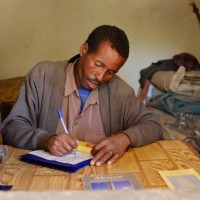 We follow his advice and visit the one attraction of Axum: the pillars of Axum. In the town, as well in its surroundings, several field with stone pillars can be found. The pillars were built around 400 ac as tomb stones. In Axum itself three pillars can be visited. One of the pillars has been in Rome for a long time, but some years ago the Italians returned it to Ethiopia. At the gate we buy a handwritten ticket. At the foot of the pillars we bump into Brian again. The roadworks took so long that his bus did not go all the way to Axum. He had to stay the night in Shire and had taken a very early bus to Axum that morning. We agree to meet for dinner that evening.
We follow his advice and visit the one attraction of Axum: the pillars of Axum. In the town, as well in its surroundings, several field with stone pillars can be found. The pillars were built around 400 ac as tomb stones. In Axum itself three pillars can be visited. One of the pillars has been in Rome for a long time, but some years ago the Italians returned it to Ethiopia. At the gate we buy a handwritten ticket. At the foot of the pillars we bump into Brian again. The roadworks took so long that his bus did not go all the way to Axum. He had to stay the night in Shire and had taken a very early bus to Axum that morning. We agree to meet for dinner that evening.
Brian advises us to go to the cattle market in Axum. It is market day today and farmers have taken their animals to the market. A good idea to visit the market! We hold a tuktuk and negotiate the price. Just when we want to get in, it appears there is already someone sitting in the back of the tuktuk. We assume that the other passenger will be dropped off and that we drive to the cattle market after that. We get in the tuktuk anyway. The cattle market is on the edge of town. The road is very bad and we are bouncing in the back of the tuktuk. When we arrive at the market area it is completely empty. No cow, sheep, goat or even a chicken. We are too late and just see the last farmer with his cattle disappear over a hill in the distance. Unlucky.
We ride back over the same bumpy road as Peter suddenly shouts: “GET YOUR HANDS OUT OF MY POCKET! That man tries to pickpocket me!” While we were tossed around the tuktuk the third passenger had put his hand in Peters pocket. Peter had initially not 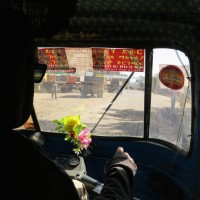 noticed. Only when he accidentally stuck his hand in his pocket he felt the hand of the other guy! Angry, Peter begins to check his pockets. It turns out that one pocket -the one with a zipper- is empty. The camera batteries and SD cards are gone.
noticed. Only when he accidentally stuck his hand in his pocket he felt the hand of the other guy! Angry, Peter begins to check his pockets. It turns out that one pocket -the one with a zipper- is empty. The camera batteries and SD cards are gone.
Peter screams that the man must give him back his stuff and begins to search the man. The door of the tuk-tuk is on my side, so long as we do not get out, the crook can get nowhere either. While the man is getting smaller and moans that he has nothing, Peter demands the driver to go to the police. Then the man starts to moan louder and points to the ground. Maybe the stuff has “fallen”? We indeed find the missing items on the floor. If we have checked all our stuff three times, we get out of the tuktuk. The thief runs away. A little confused we have the chauffeur take us to the hotel where we pay him. Once inside we realize that the driver was probably in on it. If we had realized that before, we would certainly not have paid him. We were not so streetwise yet. Fortunately, we have all our stuff back.
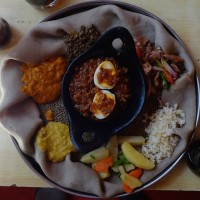 At the beginning of the evening we meet Brian and walk to a restaurant in the center. We enjoy a cold beer and injera, the national dish of Ethiopia. Injera is a pancake made of teff flour, a cereal that is grown only in Ethiopia. The injera itself is not so good and really only good to eat together with the sauce. You eat injera with your hands (if it works only with your clean right hand), by tearing off a piece of injera and taking a bit of sauce with that. It is so common that you do not even get cutlery. In North Africa, we have already learned to eat without cutlery, so we now have no problems to eat injera. Ethiopians eat injera throughout the day, at breakfast , lunch and dinner . A day no injera is a day wasted. We stick to one injera per day, Bozena Shiro is our favorite.
At the beginning of the evening we meet Brian and walk to a restaurant in the center. We enjoy a cold beer and injera, the national dish of Ethiopia. Injera is a pancake made of teff flour, a cereal that is grown only in Ethiopia. The injera itself is not so good and really only good to eat together with the sauce. You eat injera with your hands (if it works only with your clean right hand), by tearing off a piece of injera and taking a bit of sauce with that. It is so common that you do not even get cutlery. In North Africa, we have already learned to eat without cutlery, so we now have no problems to eat injera. Ethiopians eat injera throughout the day, at breakfast , lunch and dinner . A day no injera is a day wasted. We stick to one injera per day, Bozena Shiro is our favorite.
After the nasty tuktukride it is ultimately a very nice evening with Brian. He tells us about his trip (14 days in Ethiopia, Djibouti and Somaliland), about his work in San Diego and the time he worked as a volunteer in Mongolia. He also wants to know everything about our adventure. At the end of the evening he is fantasizing on which engine he could do a similar journey. He tells us about “The True Size of Africa” (see bottom of this post). Most of the “flat” world maps give a distorted picture of the true size of countries, especially those on the equator. In reality, the African continent is so big that if fits the U.S., China, India, Japan and Europe and then there is still space left! No wonder it takes us so long to cross this beautiful continent.
The next morning we sit quietly at breakfast when my phone rings. It is the gentleman of ETC who would check our dongle. As in Gonder, he concludes that the dongle works fine, but the network is down. He feels very bad, but has a solution. He is now outside our hotel with a sim card with which we can get on the Internet. The Internet will not be as fast as with the dongle, but it will work. I hurry outside. He wants to give me the ticket for free, but that really is not necessary. What a service! On a Sunday!
And he was right, with the card we did manage to get on the internet. The remainder of the day we use to read our emails and update the blog (which in the meantime was about time).
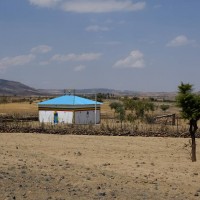 After a relaxing Sunday, we drive further Wukro on Monday to visit a rock church there. In the northern province of Tigray are more than 120 rock churches. The churches are carved into the rock and often beautifully painted. Most rock churches are very difficult to reach because they are carved into a steep cliff or hidden in a cave. Some churches may only be visited by men or by practicing Christians. The local priest determines -sometimes after an interview- whether you are allowed to visit the church. The rock church in Wukro can be accessed from the village and is open to us. On the way to Wukro we see a lot more colourful churches scattered in the landscape. Often on top of a hill, visible from far away. When we arrive in Wukro we are too late to visit the church, but we eventually go there the next morning. It is a small church with some beautiful paintings. A nice preview of what we can expect in Lalibela.
After a relaxing Sunday, we drive further Wukro on Monday to visit a rock church there. In the northern province of Tigray are more than 120 rock churches. The churches are carved into the rock and often beautifully painted. Most rock churches are very difficult to reach because they are carved into a steep cliff or hidden in a cave. Some churches may only be visited by men or by practicing Christians. The local priest determines -sometimes after an interview- whether you are allowed to visit the church. The rock church in Wukro can be accessed from the village and is open to us. On the way to Wukro we see a lot more colourful churches scattered in the landscape. Often on top of a hill, visible from far away. When we arrive in Wukro we are too late to visit the church, but we eventually go there the next morning. It is a small church with some beautiful paintings. A nice preview of what we can expect in Lalibela.
After our visit to the church in Wukro we drive to Mekele where we are invited by Kevin and Els and their children Jotan and Moshe. We met this Belgian family at Tim & Kim Village where they were on holiday when their sister (in law) Becky. They live in Ethiopia for several months now and work in the Mekele Youth Centre (MYC), a youth centre run by a major mission organization. Kevin is waiting for us in the centre of Mekele. We follow him to their house. We park our bikes in the walled garden, put our stuff in Jotans room where we can sleep and then go with the family to a restaurant nearby for a delicious burger!
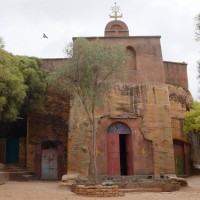 In the afternoon, Kevin takes us to the MYC where he gives us a tour and introduces us to his colleagues. The MYC is visited daily by about 800 young people from Mekele. Kevin and Els provide workshops in the field of health education. They also guide young people in their everyday problems such as housing, employment and education. A wonderful project and very inspiring to see with how committed they are to help the Ethiopian youth (see Project Manna or their Facebook). In the evening we enjoy a lovely meal made by Els, we talk endlessly about their lives in Ethiopia and I fill my time with Jotan and his book about the knights. Great we could visit them!
In the afternoon, Kevin takes us to the MYC where he gives us a tour and introduces us to his colleagues. The MYC is visited daily by about 800 young people from Mekele. Kevin and Els provide workshops in the field of health education. They also guide young people in their everyday problems such as housing, employment and education. A wonderful project and very inspiring to see with how committed they are to help the Ethiopian youth (see Project Manna or their Facebook). In the evening we enjoy a lovely meal made by Els, we talk endlessly about their lives in Ethiopia and I fill my time with Jotan and his book about the knights. Great we could visit them!
The next morning, when daily life starts again, Moshe goes to school and Kevin to the MYC. We pack our stuff and start our trip to Lalibela. More about that in a future post.
Click here to view the photos.
Distance to Mekele : 10.756km (6684 miles)
Previous story “See you, North Africa” – Next story “Rock-hewn churches of Lalibela“





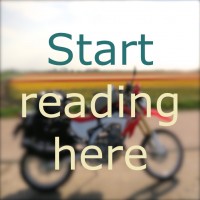


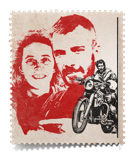

Het is, als steeds, fantastisch om te lezen wat jullie allemaal meemaken. We leren allemaal bij van jullie verhalen, echt heel bijzonder. Wel mis ik je, Le! We moeten binnenkort maar eens skypen als de verbinding zich ertoe leent. Liefs,xx
Dank, weer een prachtig verslag.